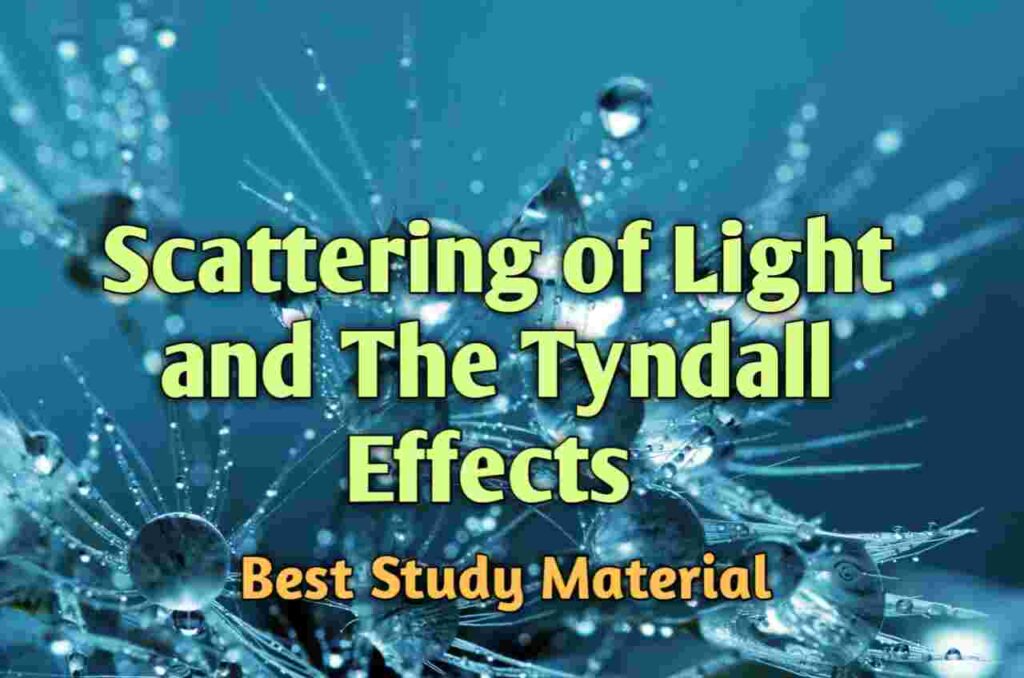Scattering of Lights
Scattering of Light refers to the absorption of light by atoms and molecules of different gases from the surroundings, as after absorbing these lights are re-emitted in all directions so the phenomena and processes are known as Scattering of Light. The atoms and molecules that are responsible for the scattering of light are known as Scattered.
Let’s examine this phenomenon, When the light is coming from their main source (Sun) it travels from one medium to another medium. So by passing from different mediums the atoms and molecules present in those mediums absorb the light from the main source and emit the radiation in all directions.
The Intensity of the scattered lights depends upon the size of the absorbed particle and its wavelength. The chance of the Scattering of light is higher when they have high frequency and short wavelength. Because of the short wavelength, they have more waviness which leads to more intersection with the particles. On the other hand, the scattering of light is lower when they have low frequency and high wavelength, as because of the high wavelength they have more straightness which leads to less intersection with the particle hence less scattering of light takes place.
As the probability of the scattering of light is inversely proportional to the Wavelength.
Sometimes the scattered light seems to be multicolored (Band of seven colors) when it is refracted from different mediums, this is because the bands of different wavelengths of light are combined in one (White Light).
Law of Scattering
According to the scattering law, the intensity of the light is inversely proportional to the 4 raised to power wavelength of light. This means more light will be scattered who have shorter wavelengths. For example blue light has a short wavelength compared with red light, thus this becomes the main reason behind the scattering of blue light are more.
Application of Scattering in daily life
The blue color of the sky
When sunlight which is the main source of energy enters the atmosphere, it starts to refract and scattering of light takes place. Here atmosphere plays an important role in scattering if there is no presence of particles in the atmosphere then there is no scattering of light takes place which seems to be a darker sky like in space. Meanwhile scattering of light Blue has short wavelengths in comparison to others (red, orange, yellow, etc) so we see our sky as blue in colour. The violet color also has a short wavelength but we can not see our sky violet because our eyes are more sensitive toward blue colors.
Red Color is used as a Danger Sign.
The wavelength of the red color is longer in comparison to others due to which it will not scatter more during the time of foggy and smoke season because of this we can see the color at far distance clearly. That’s why we use red color as a sign of Danger.
Red Sky and Sun on the time of Sun Set and Sun Rise
The color of the sky and the sun seem red at the time of Sunset and Sunrise because during that time the sun is at the farthest position from the earth. The wavelength of the red color is longer in comparison to the blue color due to which blue light scatters more. So, as a result, the red light is reached in our eye and we see the sky and sun red.
The White Colour of the Cloud
The color of the cloud seems white because the cloud is present near the earth’s surface and consists of particles and molecules bigger than the size of the wavelength of light. Due to this the light scatters in all directions from an equal extent so when the scattered light is reached by our eyes it seems to be white.
Tyndall Effects
Tyndall Effects is the phenomenon in which scattering of light takes place by colloidal particles that is Dust, Smog, and Water Droplets suspended in air. This phenomenon is shown in colloidal solutions so to verify these we have to check the solution of collids.
Take the two empty jars, and fill one jar with solution and another jar with water and milk mixture. When we pass a beam of light on both jars then we find the trajectory of the light on the milk solution jar as all the suspended colloidal particles present in them are scattering the light due to which it seems visible.
Conditions for Tyndall Effects
There are mainly two conditions of Tyndall Effects. The first one is that the wavelength of the light is bigger in comparison to the diameter of the dispersed particle. The second one is there is a great refractive index between the disperse phase and the disperse medium. Disperse medium refers to the substance present in large quantities and the fine particle present in the disperse medium is called the Disperse Phase.
Example of Tyndall Effects
- The milk contains a mixture of fats and protein so when we incident the beam of light on the milk jar we can easily show the path of light as the presence of colloidal particles scatter the light everywhere.
- Fog is a great example of the Tyndall effects. When we open the torchlight in foggy surroundings then we will clearly see the path of the light because of the scattering done by the suspended water droplets present in the environment.
How is the Tyndall Effect responsible for Blue Eyes?
The difference in the color of the Blue, Black, and Brown eyes depends on the presence of the amount of melanin present in a particular layer. As in Blue eyes, the presence of melanin is relatively low in comparison to others so when the light is incident on that layer it starts to scatter because of Tyndall Effects. We all know that blue color has a shorter wavelength due to which it scatters more in comparison to red light as a result another layer absorbs unscatter light and the majority of the light absorbed is blue due to which the iris shows the characteristics of blue colour.
Read More: Best 35 Career Options After 12th PCM 2024.






